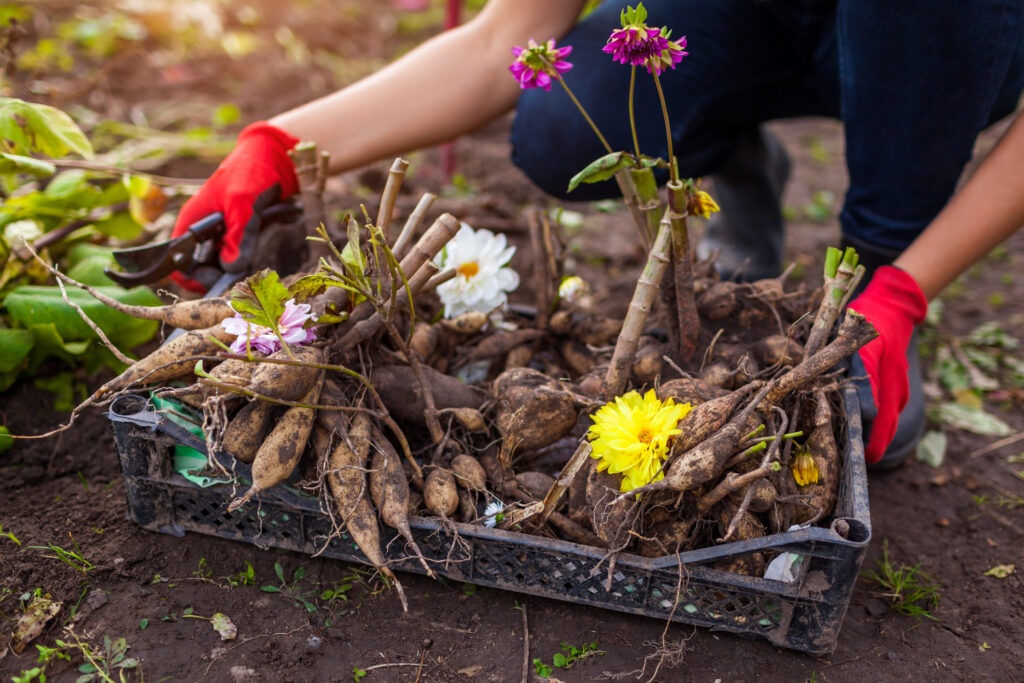Dahlias are stunning, vibrant flowers that add a burst of color to any garden. Their diverse shapes and sizes make them a favorite among gardeners. However, to ensure that these beautiful blooms thrive, it’s crucial to provide proper care to their bulbs. Here’s a detailed guide to help you care for your dahlia bulbs, from planting to overwintering.
Choosing the Right Dahlia Bulbs
Before planting, select healthy dahlia bulbs (tubers). Look for firm, plump bulbs without any signs of mold, rot, or shriveling. Healthy bulbs will ensure strong growth and abundant flowering.
Planting Dahlia Bulbs
Timing:
Plant dahlia bulbs in the spring, after the last frost has passed. Dahlias need warm soil to thrive, so wait until the soil temperature reaches at least 60°F (15°C).
Location:
Choose a sunny spot in your garden. Dahlias require at least 6-8 hours of direct sunlight daily. Ensure the location has well-drained soil to prevent waterlogging, which can cause bulb rot.
Soil Preparation:
Dahlias prefer slightly acidic to neutral soil (pH 6.0-7.0). Prepare the soil by adding compost or well-rotted manure to improve fertility and drainage.
Planting Depth:
Dig a hole about 6-8 inches deep and place the bulb with the “eyes” facing up. Cover with soil and water thoroughly. Space the bulbs about 18-24 inches apart, depending on the variety.
Watering
Dahlias need consistent moisture but dislike soggy soil. Water the plants deeply once or twice a week, depending on rainfall. Avoid overhead watering to reduce the risk of fungal diseases. Instead, use a soaker hose or water at the base of the plant.
Fertilizing
Start feeding dahlias with a balanced, water-soluble fertilizer once the plants are about 6 inches tall. A fertilizer high in phosphorus and potassium will promote blooming. Avoid high-nitrogen fertilizers, which encourage leafy growth at the expense of flowers.
Supporting Dahlias
Tall dahlia varieties require staking to prevent them from falling over. Install stakes or a support system at planting time to avoid damaging the roots later. Tie the stems to the stakes with soft garden ties, ensuring the plants remain upright as they grow.
Deadheading and Pruning
Regularly remove spent flowers (deadhead) to encourage continuous blooming. Cut the flowers back to the nearest leaf node. Additionally, pinch back the growing tips when the plants are about 12 inches tall to promote bushier growth and more blooms.
Pest and Disease Control
Monitor your dahlias for common pests like aphids, spider mites, and slugs. Use insecticidal soap or neem oil for pest control. Keep an eye out for signs of fungal diseases such as powdery mildew and botrytis. Proper spacing, good air circulation, and avoiding overhead watering can help prevent these issues.
Overwintering Dahlia Bulbs
In colder climates, dahlias will not survive the winter outdoors. Dig up the bulbs after the first frost has blackened the foliage. Carefully lift the bulbs, brush off excess soil, and let them dry in a cool, dry place for a few days.
Once dried, store the bulbs in a cool, dark, and dry location, such as a basement or garage. Place them in a container filled with peat moss, vermiculite, or sawdust to prevent them from drying out. Check the bulbs periodically during the winter to ensure they are not rotting or drying out.
Replanting in Spring
When spring returns, replant the stored bulbs following the same guidelines as before. Inspect the bulbs for any signs of rot or damage, and discard any that are unhealthy. Plant the healthy bulbs in your garden, and enjoy another season of beautiful dahlias.
Caring for dahlia bulbs requires some effort, but the reward is a garden full of stunning, colorful flowers. By following these steps, you can ensure your dahlias thrive and bring joy to your garden year after year.
Advanced Care Tips for Dahlia Enthusiasts
For those who want to take their dahlia care to the next level, here are some advanced tips and techniques to ensure your dahlias are the best they can be.
Soil Testing and Amendments
Soil Testing:
Conduct a soil test to determine the pH and nutrient levels of your garden soil. Dahlias prefer slightly acidic to neutral soil. Based on the results, you can amend the soil to create the ideal growing conditions.
Soil Amendments:
pH Adjustment: If your soil is too acidic, add lime to raise the pH. If it’s too alkaline, sulfur can lower the pH.
Organic Matter: Incorporate organic matter like compost, well-rotted manure, or leaf mold to improve soil structure and fertility.
Nutrient Balance: Add bone meal or superphosphate to increase phosphorus levels, and use potassium-rich fertilizers like wood ash or kelp meal for better blooms.
Pinching and Disbudding
Pinching:
Pinching back the growing tips when the plant reaches 12 inches tall encourages bushier growth and more flowers. This process involves removing the top 1-2 inches of the growing tip.
Disbudding:
To produce larger flowers, particularly for show dahlias, disbud the plants. This involves removing the side buds along the stem, leaving only the terminal bud. This concentrates the plant’s energy on fewer, but larger, blooms.
Pest and Disease Management
Integrated Pest Management (IPM):
Implement an IPM strategy to manage pests and diseases. This includes monitoring, biological controls, and targeted treatments to minimize chemical use.
Common Pests:
Aphids: Introduce beneficial insects like ladybugs or lacewings, or use insecticidal soap.
Spider Mites: Increase humidity around the plants and use miticides if necessary.
Slugs and Snails: Use barriers like copper tape, or organic slug pellets, and hand-pick these pests regularly.
Diseases:
Powdery Mildew: Improve air circulation, avoid overhead watering, and apply fungicides if needed.
Botrytis Blight: Remove and destroy affected plant parts, and use fungicides as a preventive measure.
Watering Techniques
Deep Watering:
Water deeply but infrequently to encourage deep root growth. This helps the plants withstand dry periods and reduces the risk of root rot.
Mulching:
Apply a layer of organic mulch around the plants to conserve moisture, suppress weeds, and regulate soil temperature.
Staking and Supporting
Sturdy Stakes:
Use sturdy stakes or a support system designed for dahlias. Place them at planting time to avoid disturbing the roots later.
Tying Techniques:
Use soft ties, such as garden twine or fabric strips, to secure the stems to the stakes. Tie loosely to allow for stem growth and movement.
Overwintering in Different Climates
Cold Climates:
In regions with harsh winters, dig up the bulbs after the first frost and store them as described earlier.
Mild Climates:
In areas with mild winters, you can leave the bulbs in the ground. However, apply a thick layer of mulch to protect them from potential frost.
Container Growing:
If you grow dahlias in containers, move them to a frost-free location during winter. Reduce watering and allow the plants to enter dormancy.
Propagation and Division
Propagation by Cuttings:
Take cuttings from healthy dahlia plants in spring. Root the cuttings in a moist, sterile medium and transplant them once they develop a strong root system.
Division:
Every few years, divide the dahlia bulbs to rejuvenate the plants and increase your stock. Divide the bulbs in spring, ensuring each division has at least one eye.
Show Preparation
Preparing Dahlias for Shows:
If you plan to exhibit your dahlias, start early by selecting the best varieties known for their form and color.
Disbud the plants to focus on larger blooms, and provide consistent care to ensure top-quality flowers.
Transporting Blooms:
Use specialized containers to transport your dahlia blooms to shows. Ensure they are well-supported to prevent damage during transit.
Dahlias are a gardener’s delight, offering vibrant colors and unique shapes. With the right care and attention, your dahlia bulbs will reward you with stunning blooms year after year. Whether you’re a novice gardener or an experienced dahlia enthusiast, these tips will help you cultivate healthy, beautiful dahlia plants.






